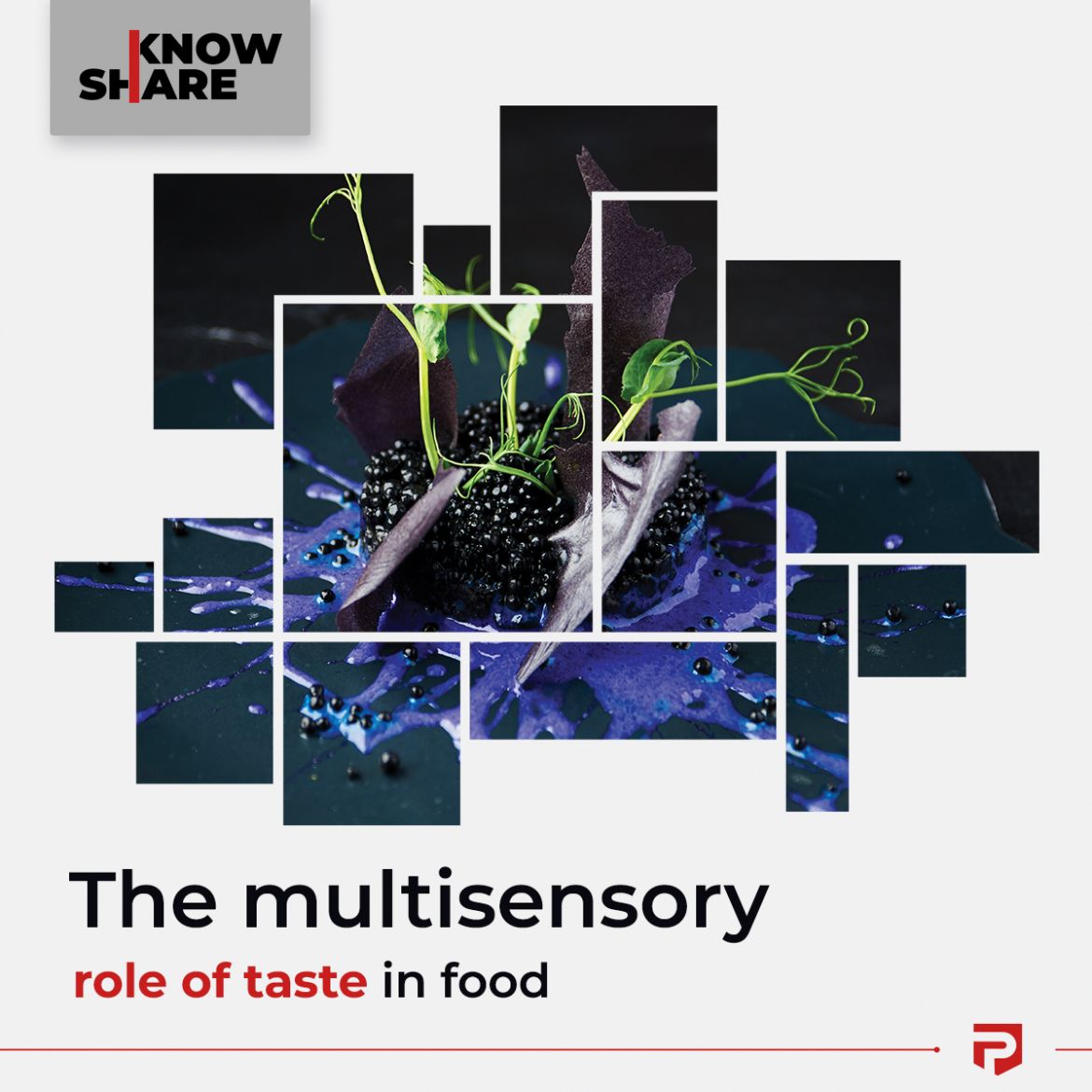Taste plays an important multisensory role in food perception, which means that it is linked to other senses and influences our overall experience of consuming food and drinks. The interaction of taste with other sensory aspects of food can have a significant impact on our preferences, experiences and consumer decisions.
Taste perception is the result of the interaction between sensory data provided by all of our senses. Taste, smell, sight, touch and hearing are connected in order to create a complete meal eating experience. The taste of food is closely related to its smell. The senses of taste and smell work together in order to provide us with a more complete taste experience. When we eat food, odor molecules floating above the food enter our olfactory receptors, which affects how we perceive the taste of the food. That is why food may seem less tasty if we have a cold and a stuffy nose. The appearance of a dish is also important for our taste experience. The color of food can indicate its quality and freshness. Moreover, the attractive appearance of a dish can increase appetite and influence our feelings and taste preferences. Food texture is another aspect that affects our taste sensations. Crispy lettuce, creamy sauce or fresh bread add variety and pleasure to eating. Although it may seem that sound is not directly related to taste, it also affects our perception of food. The sounds made when biting, crunching or swallowing can influence our perception of taste. Crispy chips or juicy fruit can give us additional pleasure from eating. Temperature also influences the perception of taste and the overall pleasure of eating. Most people prefer food that is served at the right temperature. Foods that are too cold may seem less tasty, and foods that are too hot may make them difficult to eat. Thus, the pleasure of eating is critically dependent on whether all of these sensory characteristics are correct.
However, when perceiving taste, we can’t rely only on the impressions perceived by our senses. Basically, taste is perception. Food stimulates the senses, and the brain then processes the input combined with personal memories and emotions, which makes a holistic picture of taste and what it means to us. The definition of a given taste is also shaped by our previous experiences, expectations and social context. It has a big impact on what we like to eat and drink. What is considered tasty in one culture may not be perceived the same in another. Personal experiences, the food culture in which we were brought up, the local climate and raw materials determine our preferences and consumer choices.
All of these sensory elements of food work together to create a complete and satisfying taste experience. Understanding the multisensory role of taste in food is important both for food producers who strive to create products with the best possible taste, and for consumers who want to enjoy meals at the maximum level.
At the level of culinary sciences and neuroscience, a scientific discipline called "neurogastronomy" has been created in order to study how our brain influences our taste experiences, food preferences and eating behaviors. Neurogastronomy researchers are trying to discover how the brain and nervous system can influence what we like to eat, why we like it, and how we can influence our eating habits in ways that are more beneficial to our health. Neurogastronomy can help to create new tastes, taste sensations and culinary experiences that can more effectively stimulate the mind, not just the consumer's mouth. Neurogastronomy researchers analyze how the brain processes sensory information related to taste, smell, texture and temperature of food to create a complete taste experience. This research helps understand why some flavors are more attractive than the others. This approach influences the design of dishes, drinks and meals, both those in restaurants with Michelin-stars and food in the supermarket. It is also related to the aesthetics of nutrition, a very broad field of human nutrition science, which will probably be of increasing importance for mental health. Neurogastronomy aims to integrate knowledge from neuroscience and culinary science to better understand how the brain influences our experiences with food. Research in this area has the potential to lead to more conscious and healthy food choices, as well as to improve the quality and experience of culinary pleasure.
The food design process requires taking into account all of the above aspects and balancing various factors. The goal is to create products that are tasty, healthy, socially and environmentally sustainable, accessible and affordable, as well as safe for consumers. Food production is dynamic and evolving in response to changing consumer needs and expectations and challenges related to the global food supply chain.
At PROMAR, thanks to a wide range of food additives, we can design a final product that will meet the requirements of multisensory and provide positive emotions to consumers. An extensive portfolio gives us many opportunities to shape the sensory characteristics of the product, and a modern application center enables joint tests with customers to create products worth presenting to consumers. Our innovation and creativity is the basis for being a partner in creating trends and eating habits.
Anna Płachetka
R&D Director, PROMAR PPH Sp. z o.o.
udostępnij udostępnij





